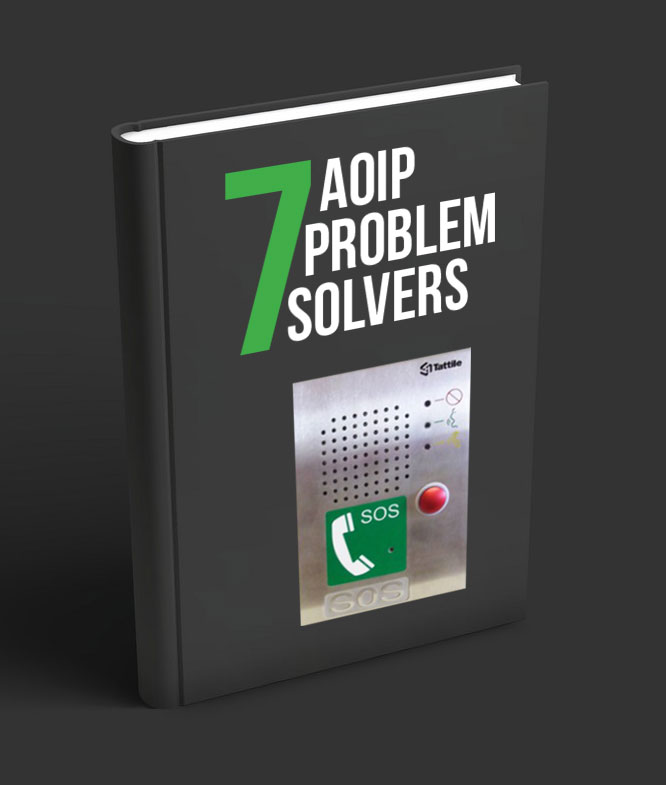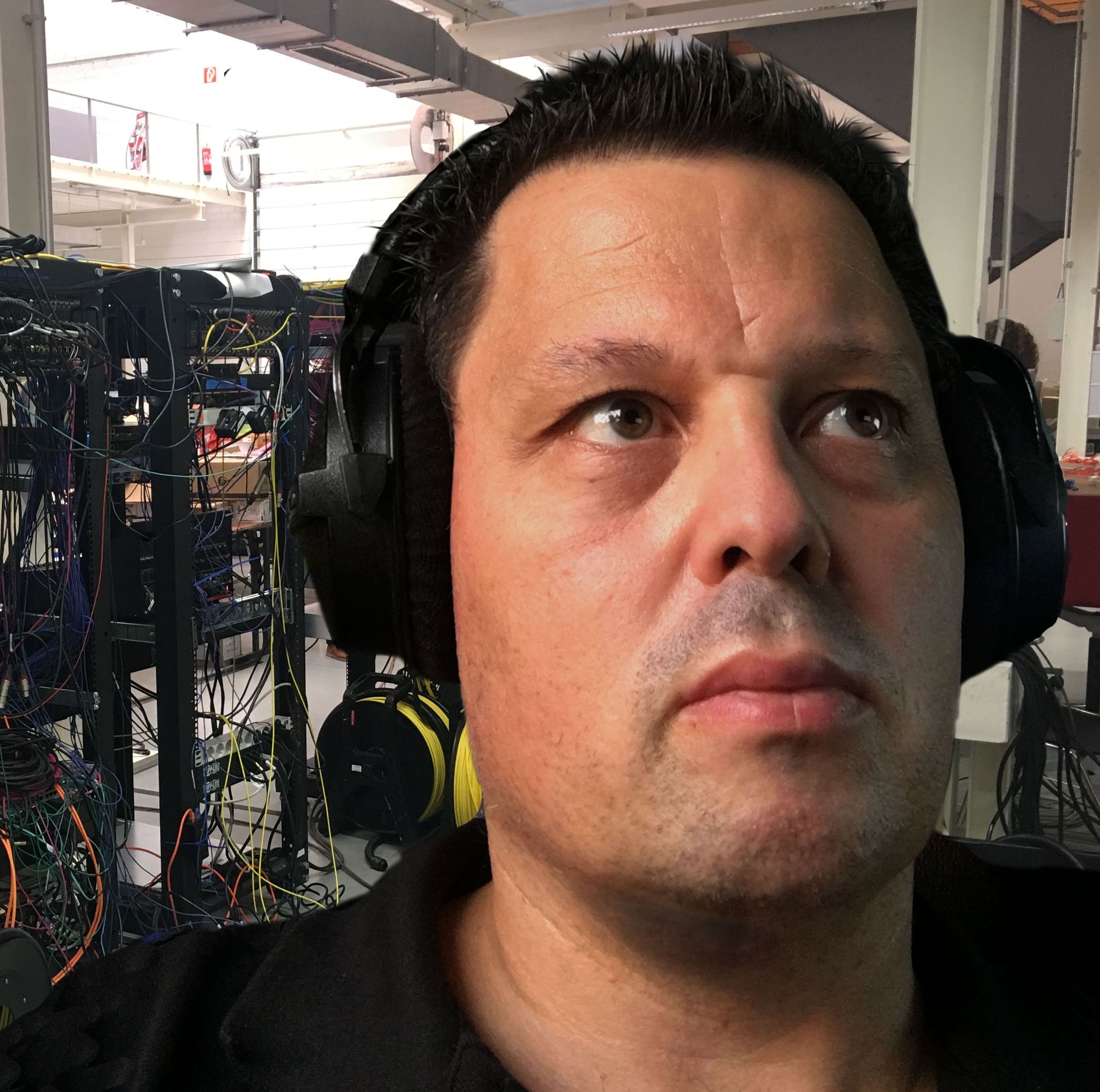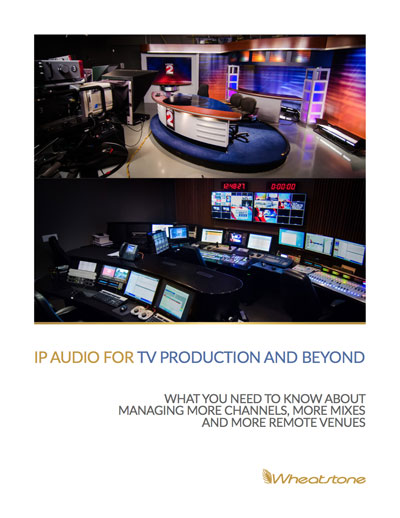WHEAT:NEWS TV SEPTEMBER 2018 Volume 5, Number 9
Plugfest 2018. We’re Not Talking.
Pictured: Danny Teunissen - all things Wheat in The Netherlands and beyond - behind the racks at Plugfest, which we are not talking about...
The first rule of Plugfest 2018 is to not talk about Plugfest 2018 so we won’t tell you that Wheatstone was there with the AES67 goods. Nor will we mention the huge strides we made in IP interoperability, or how much we enjoyed getting together with other industry manufacturers to talk IP in Wuppertal, Germany, last month.
What we can tell you is that you’ll get to hear and see the results at the upcoming IBC show.
It’ll all be laid out for you at the IP Showcase in room E106/107. You’ll get instruction, case studies, and demonstrations of what we’re talking about – or rather, not talking about. This is the third IP Showcase at IBC and it promises to capture the momentum behind the migration to standards-based IP infrastructure for real-time professional media applications.
IP Showcase is hosted by major technical and standards organizations within the broadcast industry: Audio Engineering Society (AES), Alliance for IP Media Solutions (AIMS), Advanced Media Workflow Association (AMWA), European Broadcasting Union (EBU), Society of Motion Picture and Television Engineers®(SMPTE®), and Video Services Forum (VSF).
Our AES67 compatible WheatNet-IP audio network units will be there doing their part and demonstrating AES67 compatibility in this overall showcase system based on SMPTE ST 2110 standards. AES67 is a critical part of the move to IP because as the IP audio transport standard specified in SMPTE ST 2110, it can eliminate the practice of HD/SDI audio embedding/de-embedding with video and all the hardware that goes along with HD/SDI workflows. AES67 is an IP audio multicast transport standard that uses the Precision Time Protocol IEEE 1588 as the master clock reference.
Be sure to look for our I/O BLADEs at the IP Showcase and while you’re at IBC, stop by Wheatstone stand 8.C91 and let us know what you think.
IBC 2018
September 13-18, 2018 • RAI Amsterdam • Stand 8.C91
Wheatstone will be at the the IBC Show, held in Amsterdam September 13-18, 2018. Come visit us in Stand 8.C91 and check out our latest advances in broadcast audio production, networking, and processing.

Q: We’re planning to migrate our studio facility and workflows to IP. It’ll probably happen slowly over time. Do you suggest we migrate audio and video over at the same time or separately?
A: There’s really no set way to do it because the transition is largely media independent. Some broadcasters are jumping right into IP audio now because it opens up workflow options and cost efficiencies for live production, for example. However you decide to proceed, you’ll find the transition to be fairly flexible now that audio and video no longer have to be wedded together. IP effectively eliminates the practice and costly infrastructure around HD/SDI audio embedding/de-embedding with video. Being able to separate audio and video eliminates hardware in many cases and also makes it much more expedient to add multi-language tracks or insert audio effects into a news segment, for example.
Record and Edit Simultaneously
The need to record and edit simultaneously during live shows is not uncommon in broadcasting, but it’s especially vital to sportscasters who cover live sporting events.
That explains why our VoxPro digital recorder/editor has been finding its way into sports venues of late. Commonly used for recording and editing live call-ins for morning radio shows, VoxPro is now being used by the NBA Portland Trail Blazers and other sportscasters for live coverage.
Unique to VoxPro is its controller with scrub wheel plus software editing tools designed specifically for real-time, fast-paced live production. The form and function of VoxPro is dedicated entirely to live coverage so these sportscasters can easily drag and drop sound bites into a Hotkey and add fades and effects as needed, all while editing or recording a separate track in a side window AND sending a mixdown to air!
We’re also beginning to see something else happening in the sports studio. Sound effects and music beds specific to an athlete or a particular play are being prepared in advance and recalled for playback using VoxPro’s Hotkeys.“I wouldn’t be surprised if we see many other uses for VoxPro by sportscasters as time goes on, especially now that professional games are as much multimedia spectacles as they are contests between two teams,” commented Rick “Doctor Vox” Bidlack, VoxPro systems and design engineer.
Seven AoIP Problem Solvers
 There are issues and challenges aplenty in broadcast facilities today. IP audio networking can solve a few of these. Here are seven that top the list.
There are issues and challenges aplenty in broadcast facilities today. IP audio networking can solve a few of these. Here are seven that top the list.
1. Emergency intercom. Why add onto your plant intercom when your existing IP audio network can form the communication backbone needed for a temporary back channel? Our WheatNet-IP audio network has integrated audio and control that make it possible to set up IFB communication between locations.
2. Audio, anywhere. Native analog, microphone, AES/EBU, SPDIF, AoIP, MADI, or SDI, it’s all one big happy family in the world of IP audio networking. Ingest any audio format into the WheatNet-IP audio network, and output in any audio format – go from analog to digital, AES to IP, or MADI to AES67.
3. Virtual expandability. Need to add on a newsroom, workstation or new studio? It’s all in the WheatNe-IP audio network. Create virtual mixers and other touchscreen controls using our ScreenBuilder virtual development platform, which provides the widgets and the scripting tools necessary.
4. Integrated audio routing and automation. No sound cards, external logic or added routers needed. Production automation systems integrate into the WheatNet-IP audio network system using our software ACI.
5. Change control. Change consoles or locations without having to create new logic commands. With WheatNet-IP, logic follows audio. Audio and control for that audio travel down the same cable, so you can pick up feeds and the logic for those feeds anywhere along the network.
6. Routable audio tools. For example, processors and virtual mixers are built into each WheatNet-IP I/O BLADE. With two stereo 8x2 utility mixers at the point of I/O, you can do online mixing of sounds, segue remotely between feeds, and virtually overdub and pan. Similarly, EQ dynamics and other processing tools available at I/O points in the network can be used for “spot” processing of satellite feeds, headphone audio, or web streams.
7. Redundancy. IP audio networking gives you more points of recovery should something go wrong. This is especially true of distributed and intelligent networks like WheatNet-IP that have no centralized points of failure.
FREE E-BOOK: IP AUDIO FOR TV PRODUCTION AND BEYOND
Putting together a new studio? Updating an existing studio?
We've put together this IP Audio for TV Production and Beyond e-book with fresh info and some of the articles that we've authored for our website, white papers, and news that dives into some of the cool stuff you can do with a modern AoIP network like Wheatstone's WheatNet-IP. And it's FREE to download!
Welcome To Wheatstone
Our Swiss distributors were in town and as we were showing them around, Mario was shooting video with his phone. Before we knew it, he'd made this lovely little video about his experience on the tour. We think it captures where we live and where we work very nicely.
Got feedback or questions? Click my name below to send us an e-mail. You can also use the links at the top or bottom of the page to follow us on popular social networking sites and the tabs will take you to our most often visited pages.






